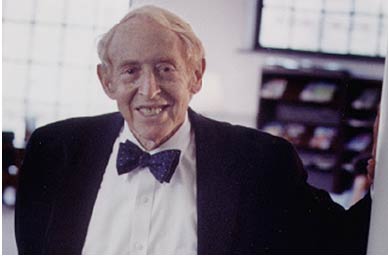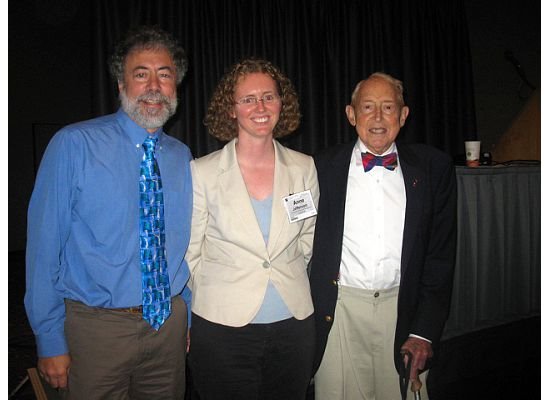![]() M. Gordon “Reds” Wolman was a towering figure in 20th century fluvial geomorphology, fundamentally shaping our understanding of river forms and processes, profoundly influencing environmental education and river management, and educating scores of students that continue to push the boundaries of our scientific understanding of landscape and hydrologic processes.
M. Gordon “Reds” Wolman was a towering figure in 20th century fluvial geomorphology, fundamentally shaping our understanding of river forms and processes, profoundly influencing environmental education and river management, and educating scores of students that continue to push the boundaries of our scientific understanding of landscape and hydrologic processes.
But to say that Reds merely educated his students is an understatement, he touched our lives. Reds was my academic grandfather (my Ph.D. advisor’s Ph.D. advisor), he was my undergraduate geomorphology professor, and he was one of a small handful of people who have profoundly influenced my career.
I’ve included below a beautiful tribute to Reds Wolman, written by his friend and colleague Peter Wilcock. Below the fold, I’ve included some of my own memories of interacting with Prof. Wolman.

M. Gordon (Reds) Wolman
August 16, 1924 – February 24, 2010
Prof. Wolman’s career was defined by fundamental contributions to our understanding of rivers, supported by pioneering work in developing interdisciplinary environmental education and an extraordinary commitment to the application of research to river management and policy.
In his Ph.D. research at Harvard University and subsequent work with Luna Leopold at the U.S. Geological Survey, Prof. Wolman played a central role in defining rivers in a modern, quantitative and generalizable framework that still provides the standard against which new models and concepts are evaluated. The understanding and the methods developed in this work form the foundation of modern river geomorphology, engineering, and restoration. Building on this work, Prof. Wolman addressed a fundamental problem in river science: the magnitude and frequency of the processes that shape rivers and their ecosystems. Is it the rare and destructive storm that sets the size, shape and composition of river channels, or the small, persistent flows, or something in between? With his colleague John Miller, Prof. Wolman demonstrated that relatively common floods do the most work in shaping river channels and, further, that there is remarkable consistency in the frequency of these ‘effective’ floods. This result has guided interpretation of rivers and challenged river theory for the past 50 years, while also providing a key element of modern channel restoration and design. Prof. Wolman’s contribution extends to the pervasive impact of urbanization on rivers. With his colleague Asher Schick, he documented the impact of urbanization on stream channels, developing a characteristic sequence of events that defines the standard model against which impacts and remediation are evaluated.
Committed to the idea that environmental stewardship requires knowledge that is both deep and broad, Reds played a leading role–by personal example, by academic leadership at Johns Hopkins University, and by advising many academic and research programs–in defining the nature and scope of effective, rigorous, and interdisciplinary environmental education.
The link between science and society was not an abstract theme for Reds, but a path to action. Reds contributed sustained service and frequent chairmanship of National Academy Commissions, Boards, and Committees dealing with water management and policy. He also provided expert guidance to Resources for the Future, the World Health Organization, the International Scientific Committee on Problems of the Environment, the International Institute for Applied Systems Analysis, Oak Ridge National Laboratory, Savannah River Plant, and the State of Maryland among others. His indefatigable service, combined with his good-natured wisdom, influenced environmental decisions and decision-makers around the world.
For those who knew him, Reds’ professional accomplishments merely provide context for his greater personal contributions through his inspired combination of warmth, wit, and genuine affection for all he came into contact with.
The whole exceeded the sum of the parts. Reds was a distinguished scholar who played a central role in defining our modern understanding of rivers, a visionary academic who pioneered integrated environmental education, a devoted citizen who worked tirelessly to apply an understanding of rivers to their protection and wise use, and an extraordinary human being who inspired and delighted generations of students and colleagues, all friends.
Wolman was one of my scientific heroes and I am forever honored to have been his student. At age 17, already a budding geomorphology geek, and familiar with some of Wolman’s work, I learned that he was a professor at The Johns Hopkins University. His residence there, accompanied my chance to meet him as a prospective student, was a factor influencing my decision to apply to and attend the university. I couldn’t wait to take classes with him, and I did take both that he offered – probably rather earlier than was good for my intellectual maturity. His course “Water Resources Development: History and Principles” and his course on “Geomorphology” were and are amazinglly influential on my thinking about the world, my research interests, and my teaching style.
Wolman was amazing: unassuming, charming, friendly, funny, compassionate. He assigned his textbook,Fluvial Processes in Geomorphology, almost apologetically (it is the classic in the field), but he never asked us to read anything from it. Instead, he had a selected, but still daunting, list of papers for each topic and he asked us to read those that we thought would be most useful and relevant to us. He was probably my first professor to emphasize the primary literature of journal articles, and now I repay that favor to my Fluvial Processes students.
In one lab exercise, Wolman taught us how to pick up and measure 100 stones in a transect across the stream bed in order to quantify the sediment size distribution. It wasn’t until several years later, as an MS student, that I discovered that that method was the “Wolman Pebble Count” technique (that I will teach to my students next week). He smoked cigars in the field and then would chuck them into the stream. I remember when I made an aghast comment about it, and he said “What? It’ll biodegrade.” Those urban Baltimore streams had certainly seen far worse insults than the biodegradable litter of a man who knew more about them than anyone else.
I’ll never forget our first geomorphology field trip. It was January, only a few weeks into the term, clear and freezing cold and he drove us who knows where in Baltimore County, then had us pile out of the van someplace along a road, with a view down out over something (doesn’t really matter what). And then he said “Tell me the story of this place.” And he waited and waited for an answer. Actually, he did the same thing on every field trip, but after a while I got better at seeing and telling those stories. And now I do it to my students.
The term paper I wrote for his geomorphology class was on islands of the Upper Mississippi River, the very same island group that one of my MS students is finally doing a proper analysis of. I remember sitting in the library and being immensely frustrated with with my lit review for the paper because every paper I read had Wolman as an author or a major reference. His work with Luna Leopold on “River channel patterns: braided, meandering, or straight” seemed to be the pivotal paper on which my whole literature review depended. Finally, I thought “Forget it, I’m going to take a break and write the section about the history of human activities on the Upper Mississippi. Surely, Wolman didn’t have anything to do with that.” He didn’t, but his father Abel Wolman, sat on the Mississippi River Commission that oversaw management of the river and the Wolman name cropped up again.
Wolman liked my term paper, and I remember that his main question to me was whether I had accounted for the varying water level elevations in my analysis of the aerial photos and maps. I hadn’t, but I make sure every time I meet with my student to remind him that he needs to take that into account. This fall, when I had a chance to chat with Woman at the Gecological Society of America meeting, he asked me whether anything had come of that islands project. He remembered my term paper from 1999! I was so proud to tell him that it really, finally was being done properly and would eventually see the light of day in journal article form.
Wolman’s lectures were amazing. He was old school, with a lot of hand-scrawled notes and the occasional handout figure photocopied from a textbook or article. He’d joke about having multimedia presentations, by which he meant blackboard +/- overhead +/- slide projector +/- maps. I joke about that too on days I use the overhead projector, and my students laugh, but they don’t know the whole story. He had an incredible ability to weave literature and history and art and everything into his lectures. My very favorite example of this was when we were talking about aeolian processes and he discussed Ralph Bagnold’s treatise on The Physics of Blown Sand. Somehow he got onto a tangent and proceeded to tell us that Bagnold’s sister was Enid Bagnold, an author who wrote National Velvet, which was a movie that starred Elizabeth Taylor. In turn, that inspired a 15 minute discourse on the relative merits of various Elizabeth Taylor movies. Yet, somehow I never minded when he ran overtime in lecture (which he usually did) and I always chose to be late to my Calculus III lectures rather than tear myself away from Wolman’s stories.
Wolman wore bow ties every day, and he drove convertibles his whole life. When I was student, the convertible was a red Miata. One summer I was working in DC and taking the train back to Baltimore late on a Friday night. I was head down in a book and I heard a friendly voice ask if the seat next to me was taken. It was Reds, of course, fresh from being honored by the National Academies, if I recall properly. So that Friday night, we spent the hour long train ride talking about geomorphology and whether I should go to field camp or study abroad. He wouldn’t hear of me taking the bus from the train station to campus, so I got to ride in that red convertible.
Wolman gave me advice on choice of graduate school and he wrote my letters of recommendation. In the end, I chose to work with Gordon Grant, who earned his Ph.D. under Wolman. While Gordon is his own creative force, I especially treasure the moments when I hear Gordon channeling Reds Wolman in his discourse. I consider myself immensely lucky to have been taught by two such insightful, inspiring, and compassionate people and to trace my academic lineage back to a pivotal person in the history of my field. Better yet is that I got to know one of my scientific heroes and know that he was indeed an amazing person.

Gordon Grant, Anne Jefferson, and M. Gordon Wolman, October 2009.



Comments (9)